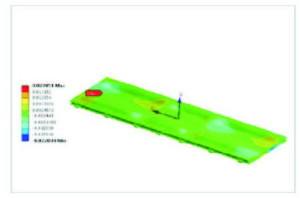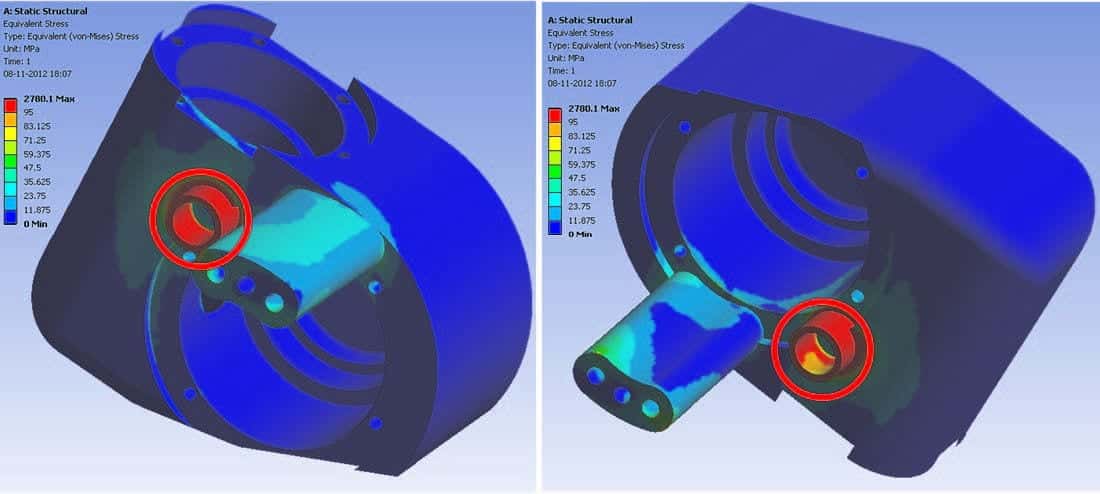seismic qualification of rto system base using finite element analysis
Innovation is our strength
CASE STUDY – Mechanical Engineering Design and Drafting Services
SEISMIC QUALIFICATION OF RTO SYSTEM BASE USING FINITE ELEMENT ANALYSIS
Engineering Design & Drafting | CAE Services: CFD & FEA | Reverse Engineering | Rapid Prototyping | Product Design | Value Engineering | PLM Services | Technical Documentation
Case Study Highlights
SEISMIC QUALIFICATION OF RTO SYSTEM BASE USING FINITE ELEMENT ANALYSIS
The Client
- Industry : Industrial Air Pollution Control Systems Manufacturer
- Location : Australia
The Objective:
- Determining the structural integrity and performance characteristics of Regenerative Thermal Oxidizer (RTO) base under different seismic loading condition.
The Solution:
- A finite element model for the RTO base was developed and modal analysis was first performed to extract first natural frequency of the base. Subsequently, seismic qualification was done using equivalent static analysis loading case, considering the first natural frequency and seismic spectrum. The results showed that the base design was safe to sustain the stresses during seismic events.
The Challenges:
- Requirement of accuracy in CAD model to ensure comprehensive details on physical behavior of the RTO base during special loading conditions
- Determining accurate loading conditions and natural frequency of the base to generate quality results for seismic qualification
- Ensuring FEA results accuracy to minimize physical validation trials
Being a global provider in developing industrial air pollution control systems, the client is into design, manufacturing, servicing and installation of thermal and catalytic oxidation technologies, as well as heat recovery systems for a variety of industrial applications. For their custom designed RTO systems for industry specific requirements, the base designed to support the system was required to be evaluated for performance and behavior under seismic events.

The Solution:
- After understanding the needs of the client it was decided to use ANSYS Mechanical to resolve the problem. Modal Analysis was carried out to extract first Natural Frequency of the RTO System Base. A Block Lancoz algorithm was used to find the first fundamental natural frequency. Seismic Qualification Analysis was performed using an Equivalent Static Analysis loading case. For this, the First Natural Frequency found out using Modal analysis was used in connection with the Spectrum to be analyzed for. The results obtained indicated that the RTO base of the client is safe under the conditions applied and used. The stresses produced under conditions were compared to the SSE allowable values and all components are safe from a strength point of view. The stiffened design of base ensures that the Base shall sustain the Loading during the specified Seismic Event.

Benefits:
- Easy validation of the base design with physical tests due to results accuracy
- Cost reduction in design development due to reduced physical test trials
- Client better understood the design behavior under seismic events and provided room to implement changes for future custom design requirements
The Objective:
- To reverse engineer steel strapping machine for design optimization and document design information digitally.
The Challenges:
- 3D scanning complex machine geometry to capture accurate geometrical dimensions.
- Performing manual dimension measurements to obtain missed-out geometrical information during the 3D scanning process.
- Developing CAD models, 3D and 2D detailed drawings for manufacturing purposes.
- Evaluating the design for stress concentration and performing subsequent optimization to propose better design of the strapping machine 3D scanning complex machine geometry to propose better design of the strapping machine.
Solution:
- The CAD model of the steel strapping machine was developed using 3D scanning technique and manual dimension measurement. In order to reverse engineer, the machine was disassembled sequentially to capture accurate geometric information of each individual component. The final design obtained was utilized to perform structural analysis for the identification of stress concentration.
- Based on the results of the analysis, the design was optimized to withstand high stress values without failure.


Reverse engineering is essentially an important method to identify flaws in the existing design of the product and improve the design subsequently, without major investment in cost and time. It is crucial to figure out the potential design errors in the product leading to premature failure.
Apart from competitive benefits, the reverse engineering process imparts manufacturers with comprehensive design information of their product, from which further innovation can be accomplished. A leading tools manufacturer from the Australia approached Australian Design and Drafting Services to reverse engineer steel strapping machine, which possessed a design flaw that led to premature failure. The client needed to investigate the problem through simulation and needed a design solution to overcome the early failure issue.
Solution:
- The steel strapping machine prototype was transformed into digital CAD model using 3D scanning technique and manual measurements. To reverse engineer the machine, individual components were disassembled and respective geometrical information was recorded to obtain accurate overall design of the machine. Individual component drawings as well as detailed manufacturing drawings were prepared. The components were then analyzed separately for structural integrity and stress concentration to identify critical areas in design requiring optimization.
- Based on the analysis results obtained, it was observed that two of the machine components needed modification in design in order to sustain stress levels resulting during the machine operation. Modifications in the design were made and the new design of the machine was proposed with better ergonomics and strength against loads to withstand premature failure.
Benefits:
- Competitive advantage in the market with improved product design.
- 30% reduction in prototyping test trials.
- Identified major design flaws with reduced turn around and faster time to market.
- Digital design documentation for future modification in design.
About Australian Design And Drafting Services
Australian Design and Drafting Services is a specialist firm providing engineering solutions to organizations across the globe. We have extensive experience in providing concept to manufacturing and post-manufacturing solutions to clients with a team of expert design engineers, CAD professionals and simulation analysts. We are based in Australia, serving 24×6, with a world-class infrastructure, hardware and software capabilities to address complex engineering problems with least turn around time.